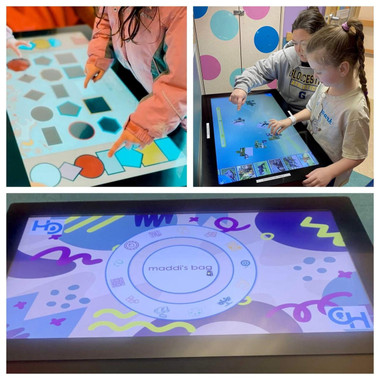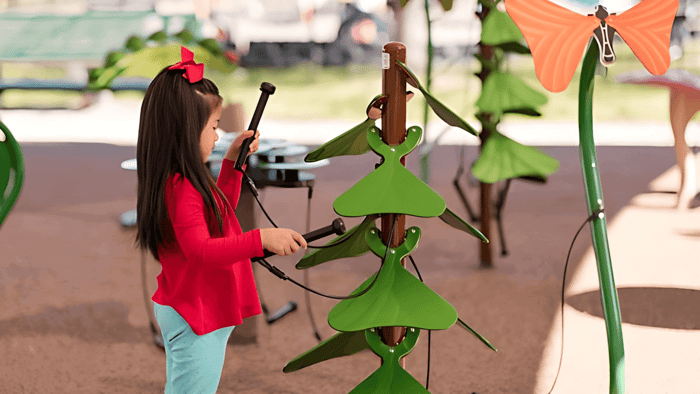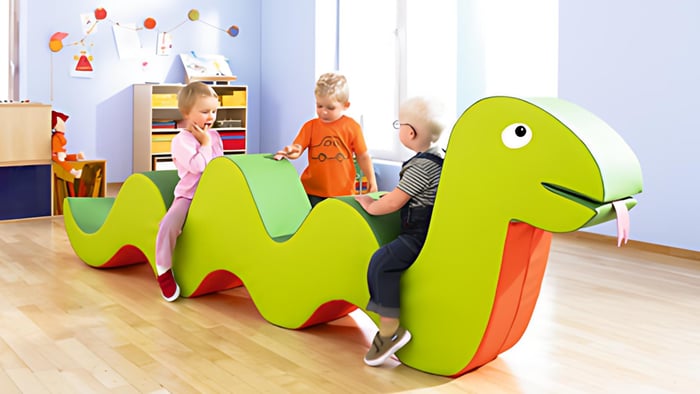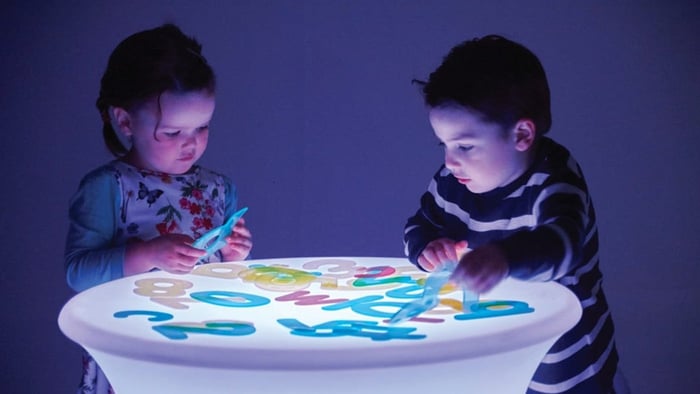
Interactive Exhibits vs. Hands-On Activities for Children Museums
Table of Contents
- Key Takeaways
- Why Both Interactive Exhibits and Hands-On Activities Drive Museum Success
- Interactive Exhibits Create Personalized Learning Experiences
- Hands-On Activities Strengthen Physical and Cognitive Development
- Strategic Implementation for Maximum Educational Impact
- Budget-Friendly Solutions for Small Museums
- A Balanced Approach Creates the Most Engaging Museum Experience
- FAQs
The debate between high-tech interactive exhibits and traditional hands-on activities misses a crucial point that most children's museums overlook. Research shows kids average 7.5 hours of daily screen time, but the real solution might surprise you.
Key Takeaways
- Both interactive exhibits and hands-on activities are essential for creating engaging children's museum experiences that support diverse learning styles and developmental needs.
- Interactive exhibits excel at personalized learning through technology-driven feedback that adapts to individual children's abilities and interests.
- Hands-on activities strengthen motor skills and provide multi-sensory experiences that support children with special learning requirements.
- Strategic blending of both approaches within single exhibits creates the most effective educational environments.
- Budget-friendly solutions exist for small museums to implement both types of experiences without major technology investments.
Children's museums face a critical decision when designing exhibits: should they prioritize high-tech interactive displays or focus on traditional hands-on activities? The answer isn't choosing one over the other, but understanding how each approach serves different aspects of childhood development and learning.
Why Both Interactive Exhibits and Hands-On Activities Drive Museum Success
The most successful children's museums recognize that interactive exhibits and hands-on activities aren't competing approaches—they're complementary strategies that address different learning needs. Interactive exhibits typically feature technology, guided tasks, or feedback mechanisms that invite children to engage directly with educational content. Hands-on activities involve physical manipulation, building, experimenting, or crafting that requires tactile involvement.
Current research indicates that children in the United States average approximately 7.5 hours of screen time daily, highlighting the importance of balanced museum experiences that provide engaging alternatives. Museums that offer both digital interaction and physical manipulation create environments where every child can find their preferred learning pathway. Little People's Cove specializes in designing these balanced educational environments that maximize engagement across different learning styles.
The key lies in understanding that these approaches serve distinct but overlapping functions. Interactive exhibits excel at providing immediate feedback and adaptive learning experiences, while hands-on activities strengthen physical development and offer open-ended opportunities. When strategically combined, they create rich learning environments that support the full spectrum of childhood development.
Interactive Exhibits Create Personalized Learning Experiences
1. Technology-Driven Feedback Adapts to Individual Children
Modern interactive exhibits use technology to provide personalized feedback that adapts to each child's responses and learning pace. Many children's museums feature interactive mirror exhibits where children can engage with smart mirrors that respond to their movements and choices. This type of technology enables museums to offer customized learning pathways that traditional static displays cannot match.
Advanced interactive systems can recognize when a child is struggling with a concept and provide additional guidance, or identify when they're ready for more challenging material. This adaptive capability makes interactive exhibits particularly valuable for accommodating children with different abilities and learning preferences within the same space.
Interactive Play Touch Table w/Custom Company Logo

$7,441.00
Creating a Memorable Guest Experience to all who visit your establishment! Perfect for kids waiting rooms, family areas, day care centers, hospitals, medical offices, schools, libraries,...… read more
2. Active Learning Through Interactive Elements Improves Memory Retention
Interactive exhibits promote active learning by requiring children to make decisions, solve problems, and engage with content rather than passively observing. This engagement style significantly improves memory retention compared to traditional display methods. Children remember experiences where they actively participated in discovering information rather than simply reading or viewing static content.
The cognitive benefits extend beyond memorization. Interactive exhibits build critical thinking skills by presenting children with choices and consequences. When children can manipulate variables and immediately see results, they develop stronger analytical thinking abilities and build robust neural connections that support future learning.
3. Real Museum Examples Show Proven Impact
The Franklin Institute demonstrates the power of interactive exhibits through displays that allow children to learn how the heart functions or how the brain sends messages throughout the body. These exhibits transform abstract biological concepts into tangible, understandable experiences that children can relate to their own bodies.
The Smithsonian's approach to virtual interactive experiences takes this concept further by turning paleontology and oceanography into interactive adventures that capture children's imagination. These real-world examples prove that well-designed interactive exhibits can make complex scientific concepts accessible and exciting for young learners.
Hands-On Activities Strengthen Physical and Cognitive Development
1. Physical Manipulation Builds Motor Skills for Real-World Tasks
Hands-on activities provide irreplaceable opportunities for developing fine and gross motor skills that children need for real-world tasks. Physical manipulation helps children strengthen hand muscles, improve accuracy, and learn functional skills needed for activities like tying shoelaces and writing. These developmental benefits cannot be replicated through screen-based interactions alone.
The tactile nature of hands-on activities also supports sensory integration, helping children process and organize sensory information more effectively. This integration is particularly valuable for younger children who are still developing their understanding of spatial relationships and cause-and-effect connections through physical activity.
2. Multi-Sensory Experiences Support Diverse Learning Needs and Special Requirements
Hands-on activities naturally incorporate multiple senses—touch, sight, sound, and sometimes smell—creating rich learning experiences that support diverse learning styles and special needs. Multi-sensory engagement is especially valuable for children with autism, ADHD, or other learning differences who may struggle with traditional educational approaches.
These experiences allow children to process information through their strongest sensory channels while simultaneously strengthening weaker areas. A child who learns best through touch can work with concepts tactilely while still developing visual processing skills through the same activity.
3. Family Participation Increases Educational Impact
Hands-on activities naturally encourage family participation, as adults can engage alongside children in building, creating, or experimenting together. This shared engagement significantly increases the educational impact for everyone involved. Parents and caregivers become active participants rather than passive observers, creating meaningful bonding experiences while reinforcing learning.
Many parents value hands-on interactive spaces in museums, finding them to be important for family engagement and repeat visits. These activities provide safe environments for families to work together, making museum visits valuable social experiences that strengthen family relationships while promoting learning.
Strategic Implementation for Maximum Educational Impact
1. Successful Museums Blend Both Approaches Within Single Exhibits
The most effective children's museums strategically blend interactive exhibits and hands-on activities within single exhibit spaces rather than treating them as separate elements. The Sciencenter in Ithaca, NY, exemplifies this approach with exhibits that combine interactive technology in their Animal Room and Changing Skies exhibit alongside hands-on building opportunities in their Build Space.
This integration allows children to move seamlessly between different types of engagement based on their interests, energy levels, and learning preferences. A science exhibit might feature an interactive digital display explaining concepts alongside a hands-on station where children can build related models or conduct experiments, creating learning experiences that reinforce key concepts through multiple modalities.
2. Clear Educational Objectives Guide Activity Design
Successful implementation requires clear educational objectives that guide both interactive and hands-on activity design. Simply offering something to touch or interact with isn't enough—each element must serve specific learning goals and encourage purposeful activity. Activities should prompt curiosity, facilitate discovery, and connect to broader educational themes.
The most effective exhibits design both interactive and hands-on elements to work together toward common learning objectives. This coordination ensures that children who prefer different engagement styles still achieve the same educational outcomes while having experiences tailored to their learning preferences.
Budget-Friendly Solutions for Small Museums
1. Low-Cost Hands-On Elements: Dress-Up Stations and Craft Tables
Small museums can create engaging hands-on experiences without significant technology investments. Dress-up stations featuring themed costumes related to exhibit topics provide highly engaging, adaptable experiences that can be refreshed with donated items. These stations scale perfectly with museum size, requiring only corner space and basic costume pieces to start.
Craft tables with simple supplies like paper, recycled materials, and crayons offer endless possibilities for themed projects that connect to exhibit content. Instructions can be swapped regularly to maintain novelty, and completed projects often generate social media sharing that extends the museum's reach beyond physical visits.
2. Community Partnerships for Supplies and Programming
Strategic community partnerships significantly reduce costs while expanding programming possibilities. Local educators, artisans, and volunteers can lead workshops or donate supplies, creating sustainable resource streams for ongoing hands-on activities. These partnerships also strengthen community connections and can lead to valuable long-term relationships.
Businesses often welcome opportunities to donate materials or sponsor activities as part of their community outreach efforts. Art stores may provide craft supplies, construction companies might donate building materials for maker spaces, and local professionals can volunteer their expertise for specialized workshops.
3. Strategic Rotation Systems That Drive Return Visits
Rotation systems maximize the impact of limited resources while encouraging repeat visits. Museums can cycle activities and displays regularly, keeping experiences fresh without constantly purchasing new materials. I Spy scavenger hunts can be redesigned with different themes using minimal investment in paper and markers, while tactile discovery tables can feature rotating collections of real objects tied to changing exhibit themes.
See-Thru Wooden Sensory Table

$942.80
SEE-THRU SENSORY TABLE Provides ultimate splash control with clear, tuff, nine-inch deep acrylic tub. Matching see-thru acrylic activity cover included. Locking casters. Ready-to-assemble. 23" wide...… read more
Discovery backpacks containing magnifying glasses, art supplies, and themed activities provide portable hands-on experiences that can be updated seasonally. These systems create anticipation for return visits while maximizing the educational value of existing resources.
A Balanced Approach Creates the Most Engaging Museum Experience
The debate between interactive exhibits and hands-on activities misses the fundamental point: children's museums serve their youngest visitors best when they provide both types of experiences thoughtfully integrated to support diverse learning needs. Interactive exhibits excel at providing personalized, adaptive learning experiences that can accommodate different abilities and interests. Hands-on activities offer irreplaceable opportunities for physical development, sensory integration, and family engagement.
The most successful children's museums recognize that not every child prefers high-tech interaction, and spaces for unstructured, screen-free activity remain highly valued. By combining both approaches strategically, museums create inclusive environments where every child can find their preferred pathway to discovery and learning. This balanced approach ensures that learning remains active, enjoyable, and memorable while supporting the full spectrum of childhood development needs.
Museums that adopt this integrated philosophy create lasting educational impacts that extend far beyond single visits, fostering curious, confident learners who carry their museum experiences into other areas of their lives.
For expert guidance on creating balanced educational environments that maximize both interactive technology and hands-on learning opportunities, visit Little People's Cove to learn about solutions for children's museum design.
FAQs
What is the difference between interactive exhibits and hands-on activities?
The main difference between interactive exhibits and hands-on activities lies in their structure and use of technology. Interactive exhibits usually incorporate technology—such as touchscreens, multimedia panels, sensors, or augmented reality—to provide multisensory engagement, personalized feedback, or digital storytelling, allowing visitors to control their learning journey and engage with content in dynamic ways. In contrast, hands-on activities are typically low-tech, focusing on direct, physical manipulation—like building, crafting, experimenting, or exploring tangible materials—which encourages discovery through touch, movement, and active participation without necessarily involving digital components. While interactive exhibits are often seen as technology-driven and can integrate digital and real-life elements, hands-on activities center on tactile, real-world experiences that may or may not involve technology, making both approaches valuable and complementary in museum environments.
Are interactive or hands-on experiences better for learning?
Interactive exhibits and hands-on activities both offer powerful opportunities for learning, but neither is inherently better; rather, they complement each other to create the most effective educational experiences. Hands-on activities excel at engaging children’s senses through direct manipulation—such as building, touching, and experimenting—which helps them understand concepts in a tangible and memorable way, especially for younger children and diverse learners. Meanwhile, interactive exhibits, especially those that use technology or feedback mechanisms, encourage curiosity, problem-solving, and collaboration, often providing tailored guidance or challenges that deepen understanding and sustain interest. Most experts and museum professionals agree that blending both approaches leads to the richest outcomes, supporting a wide range of abilities, learning styles, and age groups, and making educational content more accessible and enjoyable for all visitors.
Do these activities encourage adult or family participation, or are they just for kids?
Interactive exhibits and hands-on activities at children's museums are crafted to encourage active participation from the entire family, not just children. These experiences invite parents, caregivers, and siblings to join in play, exploration, and learning side-by-side with the children. By participating together in building blocks, arts and crafts, imaginative role-playing, or simple science experiments, families have the opportunity to bond and create shared memories in a playful, supportive environment. Museums often provide prompts and questions that adults can use to engage with children, sparking conversation and deeper understanding. This shared involvement helps children feel more confident and supported, while adults enjoy stepping back from their usual roles as teachers or facilitators and simply have fun watching and learning alongside their kids. Additionally, family participation enhances the educational benefits by allowing multi-generational learning, social connection, and ongoing conversations after the visit. This collaborative approach makes museum visits meaningful and memorable experiences for everyone involved, reinforcing learning through play and connection.



